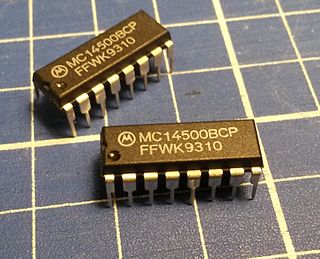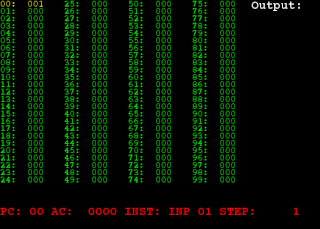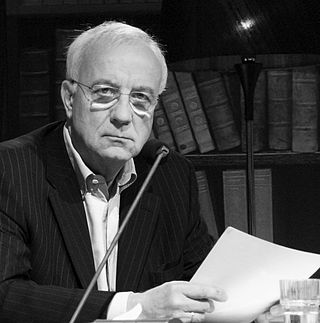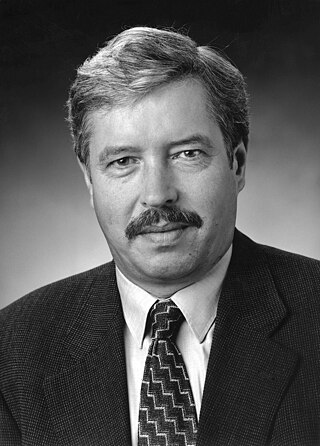
Reverse Polish notation (RPN), also known as reverse Łukasiewicz notation, Polish postfix notation or simply postfix notation, is a mathematical notation in which operators follow their operands, in contrast to prefix or Polish notation (PN), in which operators precede their operands. The notation does not need any parentheses for as long as each operator has a fixed number of operands.
A one-instruction set computer (OISC), sometimes referred to as an ultimate reduced instruction set computer (URISC), is an abstract machine that uses only one instruction – obviating the need for a machine language opcode. With a judicious choice for the single instruction and given arbitrarily many resources, an OISC is capable of being a universal computer in the same manner as traditional computers that have multiple instructions. OISCs have been recommended as aids in teaching computer architecture and have been used as computational models in structural computing research. The first carbon nanotube computer is a 1-bit one-instruction set computer.

The Z3 was a German electromechanical computer designed by Konrad Zuse in 1938, and completed in 1941. It was the world's first working programmable, fully automatic digital computer. The Z3 was built with 2,600 relays, implementing a 22-bit word length that operated at a clock frequency of about 5–10 Hz. Program code was stored on punched film. Initial values were entered manually.

The IBM 709 is a computer system that was initially announced by IBM in January 1957 and first installed during August 1958. The 709 was an improved version of its predecessor, the IBM 704, and was the third of the IBM 700/7000 series of scientific computers. The improvements included overlapped input/output, indirect addressing, and three "convert" instructions which provided support for decimal arithmetic, leading zero suppression, and several other operations. The 709 had 32,768 words of 36-bit magnetic core memory and could execute 42,000 add or subtract instructions per second. It could multiply two 36-bit integers at a rate of 5000 per second.
Excess-3, 3-excess or 10-excess-3 binary code, shifted binary or Stibitz code is a self-complementary binary-coded decimal (BCD) code and numeral system. It is a biased representation. Excess-3 code was used on some older computers as well as in cash registers and hand-held portable electronic calculators of the 1970s, among other uses.
In mathematical logic and theoretical computer science, a register machine is a generic class of abstract machines used in a manner similar to a Turing machine. All models of register machines are Turing equivalent.

The MC14500B Industrial Control Unit (ICU) is a CMOS one-bit microprocessor designed by Motorola for simple control applications in 1977.

The Z1 was a motor-driven mechanical computer designed by German inventor Konrad Zuse from 1936 to 1937, which he built in his parents' home from 1936 to 1938. It was a binary, electrically driven, mechanical calculator, with limited programmability, reading instructions from punched celluloid film.

CARDIAC (CARDboard Illustrative Aid to Computation) is a learning aid developed by David Hagelbarger and Saul Fingerman for Bell Telephone Laboratories in 1968 to teach high school students how computers work. The kit consists of an instruction manual and a die-cut cardboard "computer".
The ZEBRA was one of the first computers to be designed in the Netherlands, and one of the first Dutch computers to be commercially available. It was designed by Willem van der Poel of the Netherlands Post, Telegraph and Telephone, and first delivered in 1958. The production run consisted of fifty-five machines, manufactured and marketed by the British company Standard Telephones and Cables, Ltd.

The Digi-Comp I was a functioning, mechanical digital computer sold in kit form. It was originally manufactured from polystyrene parts by E.S.R., Inc. starting in 1963 and sold as an educational toy for US$4.99.
A counter machine or counter automaton is an abstract machine used in a formal logic and theoretical computer science to model computation. It is the most primitive of the four types of register machines. A counter machine comprises a set of one or more unbounded registers, each of which can hold a single non-negative integer, and a list of arithmetic and control instructions for the machine to follow. The counter machine is typically used in the process of designing parallel algorithms in relation to the mutual exclusion principle. When used in this manner, the counter machine is used to model the discrete time-steps of a computational system in relation to memory accesses. By modeling computations in relation to the memory accesses for each respective computational step, parallel algorithms may be designed in such a matter to avoid interlocking, the simultaneous writing operation by two threads to the same memory address.
There are many variants of the counter machine, among them those of Hermes, Ershov, Péter, Minsky, Lambek, Shepherdson and Sturgis, and Schönhage. These are explained below.

The Olivetti Programma 101, also known as Perottina or P101, is one of the first "all in one" commercial desktop programmable calculators, although not the first. Produced by Italian manufacturer Olivetti, based in Ivrea, Piedmont, and invented by the Italian engineer Pier Giorgio Perotto, the P101 used many features of large computers of that period. It was launched at the 1964 New York World's Fair; volume production started in 1965. A futuristic design for its time, the Programma 101 was priced at $3,200 (equivalent to $30,900 in 2023). About 44,000 units were sold, primarily in the US.

In computer architecture, 1-bit integers or other data units are those that are 1 bit wide. Also, 1-bit central processing unit (CPU) and arithmetic logic unit (ALU) architectures are those that are based on registers of that size.

Fritz Ferdinand Pleitgen was a German television journalist and author. He was correspondent in Moscow, East Berlin and Washington. Pleitgen was a supporter of Willy Brandt's Ostpolitik. In 1988, Pleitgen became editor-in-chief of television of Germany's then-largest public broadcaster, Westdeutscher Rundfunk (WDR), and was director of WDR from 1995 to 2007. He is regarded as one of the most influential German journalists and media makers. In 2010, he was the manager of Ruhr.2010, a project of European Capital of Culture.
WDR Computerclub was the first television broadcast in West Germany of the Westdeutscher Rundfunk (WDR) that dealt solely with the issues of computer and technology. It began its first broadcasting in 1981 under the name eff-eff, was later renamed to WDR Computerclub, and was hosted until 2003 by Wolfgang Back and Wolfgang Rudolph.

Spectre is one of the two original transient execution CPU vulnerabilities, which involve microarchitectural side-channel attacks. These affect modern microprocessors that perform branch prediction and other forms of speculation. On most processors, the speculative execution resulting from a branch misprediction may leave observable side effects that may reveal private data to attackers. For example, if the pattern of memory accesses performed by such speculative execution depends on private data, the resulting state of the data cache constitutes a side channel through which an attacker may be able to extract information about the private data using a timing attack.

Wolfgang Händler was a German mathematician, pioneering computer scientist and professor at Leibniz University Hannover and University of Erlangen–Nuremberg known for his work on automata theory, parallel computing, artificial intelligence, man-machine interfaces and computer graphics.

Norbert Ryska is a German mathematician and museum director. Ryska worked from 1976 to 1992 as an employee of Nixdorf Computer AG in the R&D department. Until 1996 as managing director and project manager on behalf of the Nixdorf Foundations mainly responsible for the construction of the Heinz Nixdorf MuseumsForum (HNF). From 1996 to 2013, Ryska was the managing director for the museum and technology departments of the HNF.














